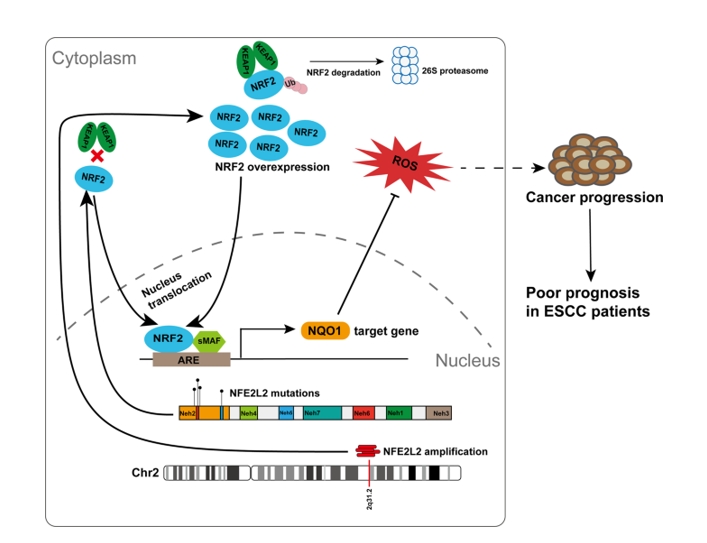What is NFE2L2 Protein
NFE2L2, or Nuclear Factor (Erythroid-Derived 2)-Like 2, is a crucial protein that plays a pivotal role in cellular defense mechanisms. Also known by its synonyms such as NRF2 (Nuclear Factor Erythroid 2-Related Factor 2) and NFE2L2-MAF KIT, this protein is a member of the cap 'n' collar (CNC) family of transcription factors. These factors are characterized by their highly conserved basic leucine zipper (bZIP) domain, a structural motif essential for DNA binding and protein-protein interactions.
NFE2L2 Protein Structural Characteristics and Classification
Structurally, NFE2L2 consists of seven functional domains, with the Neh1 domain responsible for DNA binding and the Neh2 domain playing a critical role in its regulation. Recent advances in research have shed light on the complex regulatory mechanisms governing NFE2L2 activity. Post-translational modifications, such as phosphorylation, ubiquitination, and acetylation, intricately control its stability and activity, emphasizing the intricate regulatory network that governs this protein.
NFE2L2 Biological Functions and Molecular Mechanisms
The biological functions of NFE2L2 are broad and impactful, making it a key player in cellular defense mechanisms. One of its primary roles is as a master regulator of the antioxidant response. When cells face oxidative stress, NFE2L2 is activated, leading to the transcription of a plethora of genes involved in detoxification and antioxidation. This includes genes encoding for enzymes like glutathione peroxidase, superoxide dismutase, and catalase, collectively working to neutralize reactive oxygen species (ROS) and prevent cellular damage.
Furthermore, NFE2L2 is implicated in anti-inflammatory responses and contributes to the maintenance of cellular homeostasis. It plays a role in proteostasis by regulating the expression of genes involved in the degradation of misfolded proteins. The multifaceted functions of NFE2L2 underscore its significance in preserving cellular integrity and combating various stressors.

Figure 1. Schemic diagram of NFE2L2 somatic alterations on the prognosis of ESCC patients. (Jiang X, et al., 2022)
NFE2L2 Related Signaling Pathway
The Keap1-NFE2L2-ARE (antioxidant response element) pathway is the principal signaling cascade governing NFE2L2 activation. Under normal conditions, NFE2L2 is sequestered in the cytoplasm by Kelch-like ECH-associated protein 1 (Keap1). However, in the presence of oxidative stress, Keap1 undergoes conformational changes, leading to the release and subsequent nuclear translocation of NFE2L2. Once in the nucleus, NFE2L2 binds to the ARE, initiating the transcription of antioxidant and detoxification genes.
This tightly regulated pathway ensures that NFE2L2 responds promptly to environmental stressors, highlighting its adaptive and protective role in cellular defense.
NFE2L2 Related Diseases
Dysregulation of NFE2L2 has been linked to several diseases, emphasizing its critical role in health and disease. In conditions where oxidative stress is a contributing factor, such as neurodegenerative disorders (e.g., Alzheimer's and Parkinson's diseases) and cardiovascular diseases, abnormalities in NFE2L2 signaling have been observed. Conversely, excessive activation of NFE2L2 is associated with certain cancers, highlighting its context-dependent role in disease pathogenesis.
Understanding the delicate balance of NFE2L2 in different cellular contexts is crucial for developing targeted therapeutic interventions for diseases linked to its dysregulation.
NFE2L2's Applications in Biomedicine
The unique properties of NFE2L2 make it a promising candidate for various biomedical applications. In diagnostics development, NFE2L2 expression levels could serve as biomarkers for oxidative stress-related diseases. Monitoring NFE2L2 activity could provide valuable insights into the overall cellular health and response to environmental stimuli.
In vaccine development, harnessing the immunomodulatory functions of NFE2L2 could enhance the efficacy of vaccines by promoting a robust and balanced immune response. Research in this area holds the potential to revolutionize vaccine design, especially in combating infectious diseases.
From a therapeutic perspective, targeting the NFE2L2 pathway is being explored as a strategy for diseases where oxidative stress plays a prominent role. Small molecules and compounds that modulate NFE2L2 activity are under investigation for their therapeutic potential, offering a novel avenue for drug development.
Recommended Products
| Cat.# | Product name | Species | Source (Host) | Tag |
|---|---|---|---|---|
| NFE2L2-30414TH | Recombinant Human NFE2L2 | Human | Wheat Germ | N/A |
| NFE2L2-8469H | Recombinant Human NFE2L2, His-tagged | Human | E.coli | His |
| NFE2L2-359H | Recombinant Human NFE2L2 protein, His/MBP-tagged | Human | E.coli | His/MBP |
| NFE2L2-1917H | Recombinant Human NFE2L2 protein, His & GST-tagged | Human | E.coli | His/GST |
| NFE2L2-001H | Recombinant Human NFE2L2 Protein, MYC/DDK-tagged | Human | HEK293T | Myc/DDK |
| NFE2L2-4685H | Recombinant Human NFE2L2 Protein, Myc/DDK-tagged, C13 and N15-labeled | Human | HEK293T | Myc/DDK |
| NFE2L2-4426H | Recombinant Human NFE2L2 protein, His-tagged | Human | E.coli | His |
| NFE2L2-154HFL | Recombinant Full Length Human NFE2L2 Protein, C-Flag-tagged | Human | Mammalian cells | Flag |
| NFE2L2-1211H | Recombinant Human NFE2L2 protein, GST-tagged | Human | E.coli | GST |
| NFE2L2-4688H | Recombinant Human NFE2L2 Protein (Met17-Asn605), N-His tagged | Human | E.coli | N-His |
Reference
- Jiang X, et al. High expression of nuclear NRF2 combined with NFE2L2 alterations predicts poor prognosis in esophageal squamous cell carcinoma patients. Modern Pathology. 2022, 35(7): 929-937.

